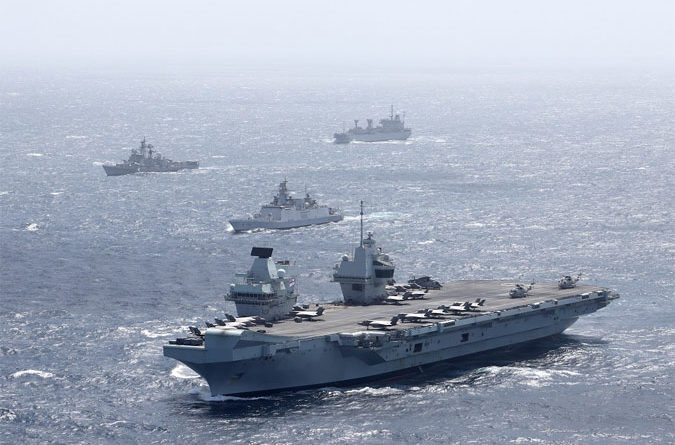UK Carrier Strike Group Starts Maritime Exercises With Indian Navy
Jul 22, 2021
The joint endeavour is aimed at providing “tangible” security to friendly countries and a credible deterrence to those who seek to undermine global security.
The United Kingdom’s Carrier Strike Group (CSG) 2021, led by the HMS Queen Elizabeth aircraft carrier, has met up with the Indian Navy in the Bay of Bengal for three days of complex maritime interactions, the British government said on Thursday.
The maritime partnership exercise between the Indian Navy and the Royal Navy will see the two navies conducting a range of multiship, air, sea and sub-surface maritime evolutions, as well as close quarter manoeuvring.
This enables both forces to advance their interoperability and cooperation ahead of further exercises when the CSG returns to the Indian Ocean in the autumn, the UK government said.
The combined forces for the exercises equate to 10 ships, two submarines, approximately 20 aircraft and almost 4,000 personnel.
“This is a month that will see the Royal Navy and Indian Navy meet and work together in two oceans – beginning in the Indian Ocean as the UK Carrier Strike Group arrives for the first of multiple UK-India exercises and events,” said Admiral Sir Tony Radaki, First Sea Lord of the Royal Navy.
“Later this summer, both will participate in a separate exercise in the Atlantic Ocean. The deployment is proof of the strength, energy and significance of the growing relationship between our navies,” he said. An Indian warship will also exercise with the Royal Navy off the coast of the UK in August.
“The UK and India are key defence partners and the Carrier Strike Group’s deployment is a symbol of Global Britain in action, showcasing our commitment to India, the Indo-Pacific region, and confronting threats to international order,” said Vice Admiral Sir Ben Key, the UK’s Chief of Joint Operations.
According to the UK Foreign Office, both the UK and India are in the midst of a carrier renaissance, with the CSG spearheading the UK’s Joint Expeditionary capability.
The joint endeavour is aimed at providing “tangible” security to friendly countries and a credible deterrence to those who seek to undermine global security.
Commodore Steve Moorhouse, Commander United Kingdom Carrier Strike Group, added: “As HMS Queen Elizabeth and her Carrier Strike Group cross the Indian Ocean, it is only natural that we should exercise with the Indian Navy.
“At the strategic level, the exercise is a muscular expression of the closer defence partnership that Prime Ministers Johnson and Modi envisaged when they agreed the UK-India Roadmap 2030 earlier this year.”
As part of its maiden operational deployment, the CSG will sail over 26,000 nautical miles, engaging with 40 countries from the Mediterranean to the Indo-Pacific and back again.
The fifth generation HMS Queen Elizabeth carrier, at 65,000 tonnes, is said to be the largest surface vessel ever constructed in the UK and leads six Royal Navy ships, a Royal Navy submarine, a US Navy destroyer and a frigate from the Netherlands in one of the largest concentration of maritime and air power from the UK.
The deployment has been termed a “step-change” in the UK’s engagement in the Indo-Pacific region, covering aspects of defending democratic values, tackling shared threats and seizing new trade opportunities.
Courtesy: ET

